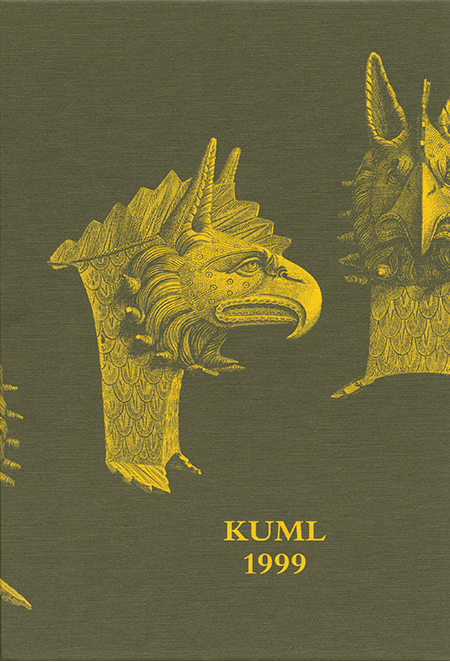Hans Jørgen Madsen
the Worsaae Medal 13th of May 1999
DOI:
https://doi.org/10.7146/kuml.v13i13.113599Keywords:
Worsaae medal, hans jørgen madsenAbstract
Hans Jørgen Madsen
- the Worsaae Medal 13th of May 1999
Hans Jørgen Madsen retired on the 1st of July 1999 after having been a curator at Moesgård Museum for 35 years and after many active years in the Archaeological Society of Jutland, first as the leader of the local district from 1970, then as the general secretary of this society from 1982.
Hans Jørgen Madsen was born in Svebølle in West Sealand in 1937 as the son of a dairy owner. He grew up in an area rich with relics of the past and close to the Åmose bog and the Halleby Å stream. Here his interest in the past and in archaeology was awakened. In 1955, he became a student at the Dental College in Copenhagen, but he soon changed his mind and began training as a teacher at the college of education in Århus. Here he chose history and religion as his main subjects. At the same time, he began studying archaeology at Aarhus University under Professor P. V. Glob.
At first he considered the study of archaeology an interesting hobby, which he would now have the opportunity of getting more acquainted with while studying for his future profession as a teacher. However, having finished his teacher training in 1959, he began studying archaeology full time and passed his MA degree in the summer of 1964. Hans Jørgen Madsen finished on a Friday and started on the following Monday as a curator leading the excavations under the old Scandinavia Hotel in the centre of Århus together with curator H. Hellmuth Andersen. Nowadays, such a quick change from studies to permanent work is rather unusual. While studying, Hans Jørgen Madsen -or Mads, as friends and colleagues call him- had taken part in quite a few excavations, in Denmark and abroad. However, his first excavation as a curator in the centre of Århus was also the beginning of his life's work, the study of Århus during the Viking Age and the Middle Ages. In 1971, the book "ÅRHUS SØNDERVOLD, en byarkæologisk undersøgelse" was published. In this he and his coauthors Hellmuth Andersen and Peter Crabb presented the archaeological investigations of Skt. Clemens Torv. The book was beautifully illustrated and designed by Flemming Bau, and its high professional level has since served as a model for the publication of urban archaeology. Later, Mads undertook many investigations in the city of Århus, which he published in a number of articles and rounded off beautifully in the first volume of "Århus Byens Historie", published in 1996. Here, he paints the picture of the early topography of the city with a steady hand. The cooperation with Hellmuth Andersen continued in the investigation in the early 1970ies of Danevirke, in which Olfert Voss took part. The results were published in two volumes. Further, Mads has undertaken numerous archaeological investigations in the local district as well as in the rest of Jutland. However, the archaeological investigations undertaken with curator Jens Jeppesen at the church of Lisbjerg seem. to have been his favoured task, perhaps because they unite history and religion -Mads' two interests and the main subjects from his days at the college of education. The results were published recently in KUML under the headline "A wooden church and big man's hall at Lisbjerg".
Mads' recurrent remark that he has not written much is a somewhat modest statement, considering that his list of publications holds around seventy titles. He has written on countless subjects and has been a frequent supplier of articles for the SKALK magazine. The headlines of the SKALK-articles were, among others, "The cheeky frog", "A Monster in Århus", and "The Mad Sailor"- titles worthy of Edgar Allan Poe. The results of his archaeological investigations have also been popularised in other ways, such as the town hall exhibition during the Festival Week of 1966, the "cellar museum" presenting the results of the Søndervold excavation, which opened in 1967, and the Viking exhibition at Moesgård, created for the opening in 1970. Further, he has held many talks and lectures, and evidently liked visiting village halls to tell about his work.
Precision and fulfilment characterise Mads' work. Thorough excavations are documented in scholarly journals and published in popular articles and magazines. He certainly finishes off his work more thoroughly than most of his colleagues.
As for administration, Mads has been a member of the Council of Ancient Monuments and the Archaeology Board and chairman of the board of Århus City Museum. Still, he probably put most energy into the Archaeological Society of Jutland and the Moesgård district of this society for which he carefully arranged lectures and excursions.
At Moesgård Museum, Mads' friendliness and humour, his composure and his breadth of view will be much missed. At Christmas, the museum staff and the Moesgård district of the Archaeological Society of Jutland will suffer the loss of his legendary recitations of the Yule feast at Harold Bluetooth 's hall from the novel "Red Worm" by Frans G. Bengtsson. The Keeper of National Antiquities, Mr Steen Hvass, presented Hans Jørgen Madsen with the Worsaae Medal at the general assembly of the Archaeological Society of Jutland on the 13th of May 1990.
Jan Skamby Madsen
Downloads
Published
How to Cite
Issue
Section
License
Fra og med årgang 2022 er artikler udgivet i Kuml med en licens fra Creative Commons (CC BY-NC-SA 4.0).
Alle tidligere årgange af tidsskriftet er ikke udgivet med en licens fra Creative Commons.


